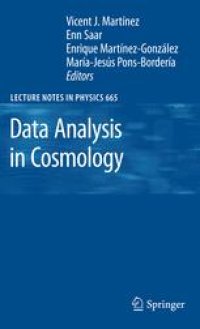
Ebook: Data Analysis in Cosmology
- Genre: Physics // Astronomy: Astrophysics
- Tags: Relativity and Cosmology, Statistics for Engineering Physics Computer Science Chemistry & Geosciences, Numerical and Computational Methods
- Series: Lecture Notes in Physics 665
- Year: 2009
- Publisher: Springer-Verlag Berlin Heidelberg
- Edition: 1
- Language: English
- pdf
The amount of cosmological data has dramatically increased in the past decades due to an unprecedented development of telescopes, detectors and satellites. Efficiently handling and analysing new data of the order of terabytes per day requires not only computer power to be processed but also the development of sophisticated algorithms and pipelines.
Aiming at students and researchers the lecture notes in this volume explain in pedagogical manner the best techniques used to extract information from cosmological data, as well as reliable methods that should help us improve our view of the universe.
The amount of cosmological data has dramatically increased in the past decades due to an unprecedented development of telescopes, detectors and satellites. Efficiently handling and analysing new data of the order of terabytes per day requires not only computer power to be processed but also the development of sophisticated algorithms and pipelines.
Aiming at students and researchers the lecture notes in this volume explain in pedagogical manner the best techniques used to extract information from cosmological data, as well as reliable methods that should help us improve our view of the universe.
The amount of cosmological data has dramatically increased in the past decades due to an unprecedented development of telescopes, detectors and satellites. Efficiently handling and analysing new data of the order of terabytes per day requires not only computer power to be processed but also the development of sophisticated algorithms and pipelines.
Aiming at students and researchers the lecture notes in this volume explain in pedagogical manner the best techniques used to extract information from cosmological data, as well as reliable methods that should help us improve our view of the universe.
Content:
Front Matter....Pages i-xii
Front Matter....Pages 1-1
The Sea of Wavelets....Pages 3-50
Fisher Matrices and All That: Experimental Design and Data Compression....Pages 51-72
Data Compression, Classification and Parameter Estimation. Methods: Examples from Astronomy....Pages 73-76
Front Matter....Pages 77-77
Cosmic Microwave Background Anisotropies: The Power Spectrum and Beyond....Pages 79-120
Cosmic Microwave Background Polarization Analysis....Pages 121-158
Diffuse Source Separation in CMB Observations....Pages 159-205
Techniques for Compact Source Extraction in CMB Maps....Pages 207-235
Determination of Cosmological Parameters from Cosmic Microwave Background Anisotropies....Pages 237-259
Cosmic Microwave Background Data Analysis: From Time-Ordered Data to Angular Power Spectra....Pages 261-265
Front Matter....Pages 267-267
The Large-Scale Structure in the Universe: From Power Laws to Acoustic Peaks....Pages 269-289
The Cosmic Web: Geometric Analysis....Pages 291-413
Power Spectrum Estimation. I. Basics....Pages 415-431
Power Spectrum Estiamtion II. Linear Maximum Likelihood....Pages 433-456
Introduction to Higher Order Spatial Statistics in Cosmology....Pages 457-492
Phase Correlations and Topological Measures of Large-Scale Structure....Pages 493-522
Multiscale Methods....Pages 523-563
Gaussian Fields and Constrained Simulations of the Large-Scale Structure....Pages 565-583
Weak Gravitational Lensing....Pages 585-600
Mass Reconstruction from Lensing....Pages 601-627
Back Matter....Pages 1-8
The amount of cosmological data has dramatically increased in the past decades due to an unprecedented development of telescopes, detectors and satellites. Efficiently handling and analysing new data of the order of terabytes per day requires not only computer power to be processed but also the development of sophisticated algorithms and pipelines.
Aiming at students and researchers the lecture notes in this volume explain in pedagogical manner the best techniques used to extract information from cosmological data, as well as reliable methods that should help us improve our view of the universe.
Content:
Front Matter....Pages i-xii
Front Matter....Pages 1-1
The Sea of Wavelets....Pages 3-50
Fisher Matrices and All That: Experimental Design and Data Compression....Pages 51-72
Data Compression, Classification and Parameter Estimation. Methods: Examples from Astronomy....Pages 73-76
Front Matter....Pages 77-77
Cosmic Microwave Background Anisotropies: The Power Spectrum and Beyond....Pages 79-120
Cosmic Microwave Background Polarization Analysis....Pages 121-158
Diffuse Source Separation in CMB Observations....Pages 159-205
Techniques for Compact Source Extraction in CMB Maps....Pages 207-235
Determination of Cosmological Parameters from Cosmic Microwave Background Anisotropies....Pages 237-259
Cosmic Microwave Background Data Analysis: From Time-Ordered Data to Angular Power Spectra....Pages 261-265
Front Matter....Pages 267-267
The Large-Scale Structure in the Universe: From Power Laws to Acoustic Peaks....Pages 269-289
The Cosmic Web: Geometric Analysis....Pages 291-413
Power Spectrum Estimation. I. Basics....Pages 415-431
Power Spectrum Estiamtion II. Linear Maximum Likelihood....Pages 433-456
Introduction to Higher Order Spatial Statistics in Cosmology....Pages 457-492
Phase Correlations and Topological Measures of Large-Scale Structure....Pages 493-522
Multiscale Methods....Pages 523-563
Gaussian Fields and Constrained Simulations of the Large-Scale Structure....Pages 565-583
Weak Gravitational Lensing....Pages 585-600
Mass Reconstruction from Lensing....Pages 601-627
Back Matter....Pages 1-8
....